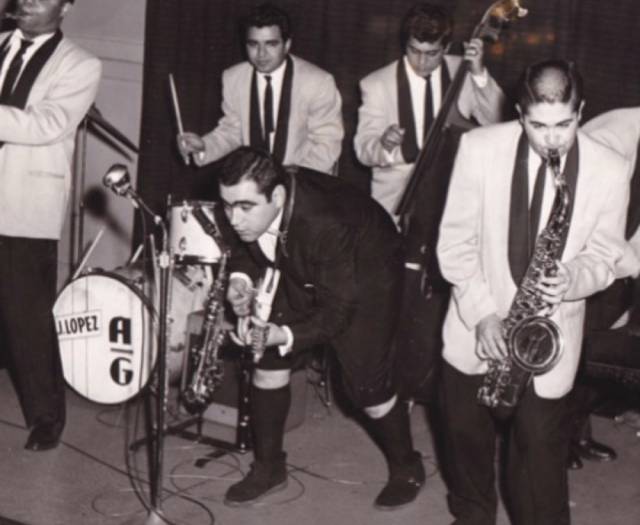Garcia was born on February 13, 1932, in St. Paul’s Flats—a vibrant Latino and Mexican American neighborhood on the city’s west side. His uncle Frank bought him his first guitar and taught him to play, while weekends meant family gatherings filled with songs in Spanish alongside his father and uncle. Those early rhythms and vocal traditions would later shape his distinctive performance style. At just seventeen, Garcia made his television debut on WTCN-TV in 1949 with fellow musicians and local restaurant owner Vera “Mama” Coronado.
In the early 1950s, Garcia formed his first band, the Continentals, with bassist Mike Continelli. Their sound—called ‘kicksy’ before the term ‘rock ’n’ roll’ was widely used—drew attention across the Twin Cities Then the Korean War hit. Garcia was drafted, and his music career went on hold.
Returning home from the war around 1954, where he had been awarded a Purple Heart, Garcia wasted no time getting back to music. He put together a new group, the Augie Garcia Quintet, which became one of the Twin Cities’ most dynamic live acts. The band became a fixture at the River Road Club in Mendota, where their Fats Domino-inspired combination of rhythm and blues and rock 'n' roll packed the venue night after night. In 1955, they recorded “Hi Yo Silver,” widely recognized as Minnesota’s first true rock 'n' roll record.
Garcia's real strength was his stage presence. He jumped on pianos, rolled across the floor, and performed in a blazer and his trademark Bermuda shorts, a style he picked up during a layover in Hawaii on his way to Korea. On May 13, 1956, when the Quintet opened for 21-year-old Elvis Presley at the St. Paul Auditorium, Garcia tore through his set with such intensity that Colonel Tom Parker reportedly cut it short after a couple of songs, worried the local act might overshadow Elvis.
By the late 1950s, the Augie Garcia Quintet had become a Twin Cities institution. Their residency at the River Road Club drew crowds from across Minnesota who came for Garcia's frenetic performances and the band's driving rhythm-and-blues sound. They recorded several regional hits—‘River Road Boogie’ and ‘Let the Good Times Roll’ among them—selling more than 100,000 singles, an impressive feat for a local act in the pre-Beatles era.
Despite their growing success, Garcia and his bandmates chose to remain rooted in the Twin Cities rather than pursue national fame. Offers came in from outside the region, but commitments to family, education, and steady jobs kept them home. Their decision reflected both practicality and pride in the thriving local scene they had helped create. By 1962, as musical tastes shifted and the members drifted into new phases of life, the Quintet quietly called it quits.
Garcia stepped away from full-time performing and found steady work as an ironworker on Minneapolis high-rises, joking that he was “walking on the sidewalks in the sky.” Yet music never left him entirely. He met his future wife, Nancy, while performing at a local club—they married in 1966 and raised two daughters, Angie and Elena. By the late 1960s, Garcia was again playing small gigs at restaurants and private events, performing for the joy of it rather than ambition. On April 20, 1996, four decades after his first hit, he reunited with his band for a sold-out concert at St. Paul’s Prom Center. Governor Arne Carlson proclaimed it “Augie Garcia Day,” recognizing his four-decade-long contribution to Minnesota music.
On August 6, 1999, Garcia died of esophageal cancer. He bridged St. Paul’s West Side Latino community with Minnesota’s emerging rock scene, fusing Latin rhythms with R&B and jump blues into something unmistakably his own. In 2015, River Road Boogie: The Augie Garcia Story brought his music back to Twin Cities stages. A decade later, on April 25, 2025, he was inducted into the Minnesota Music Hall of Fame, cementing his place in the state’s musical history.
 Minnesota Then
Minnesota Then
